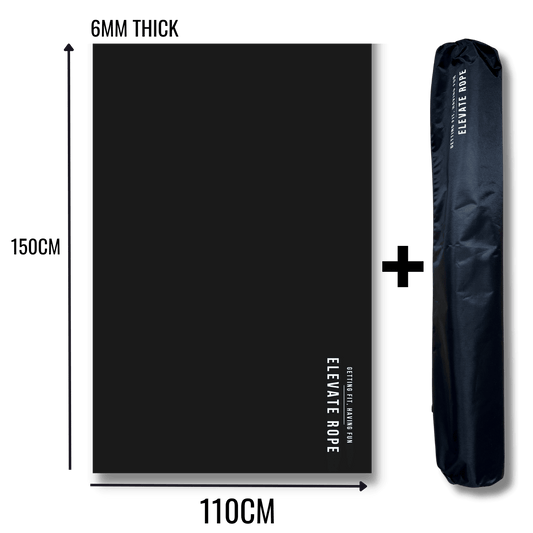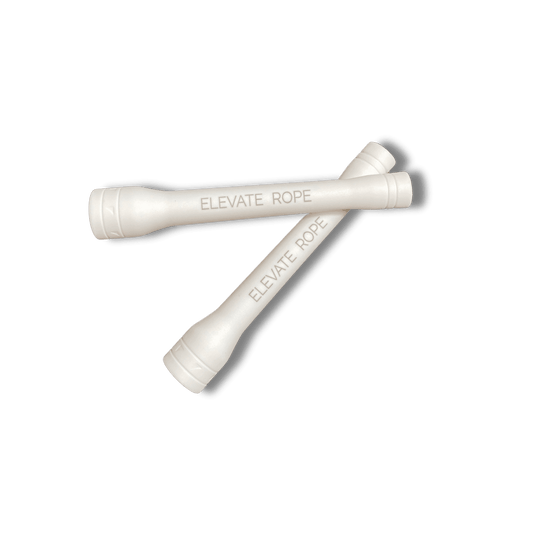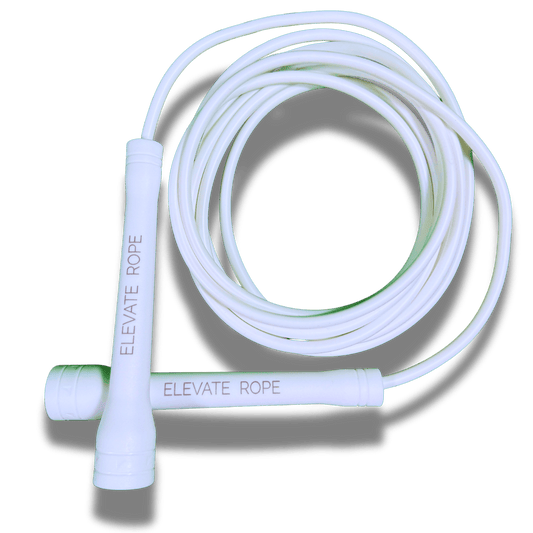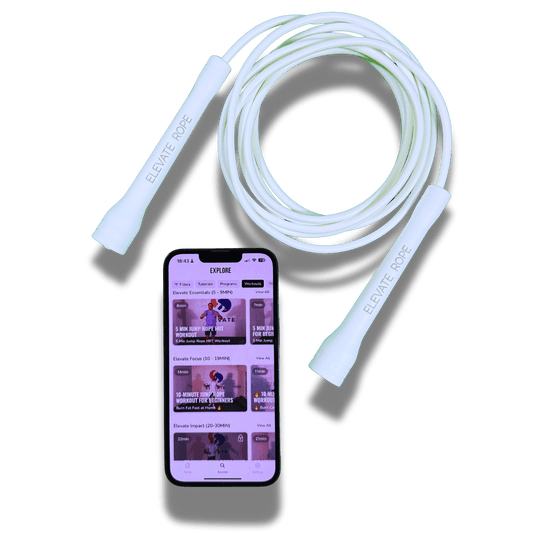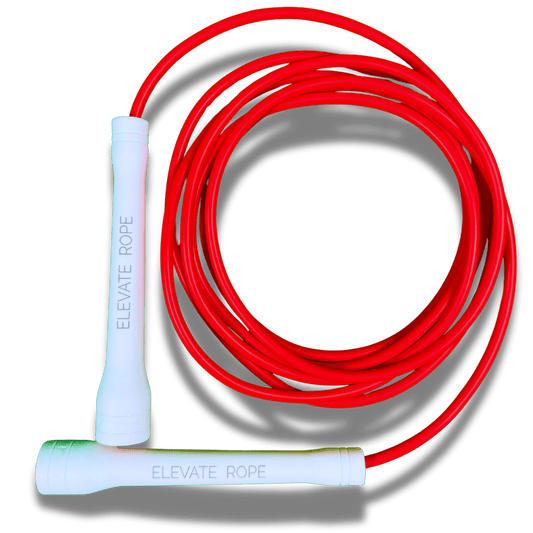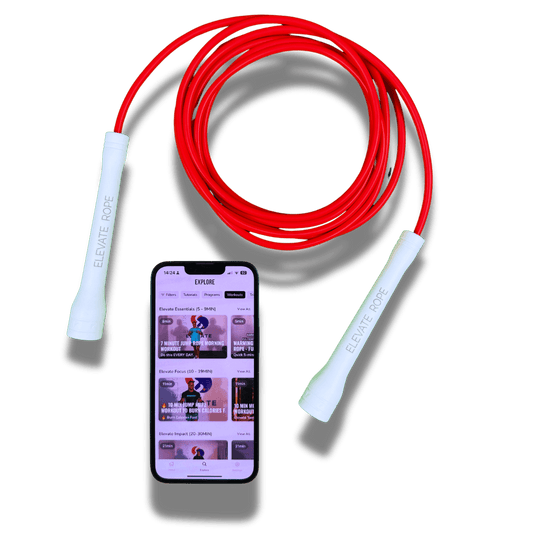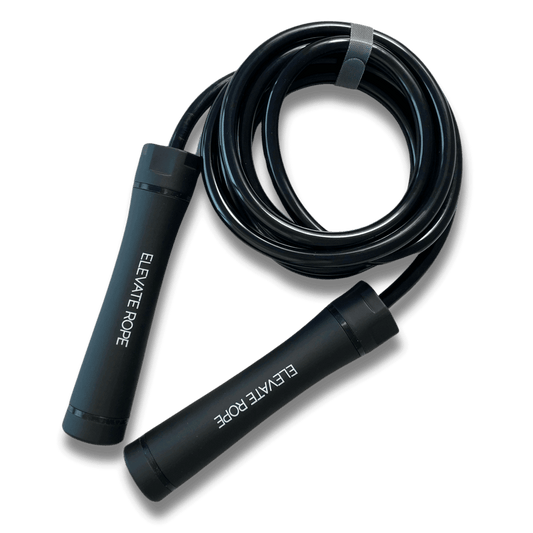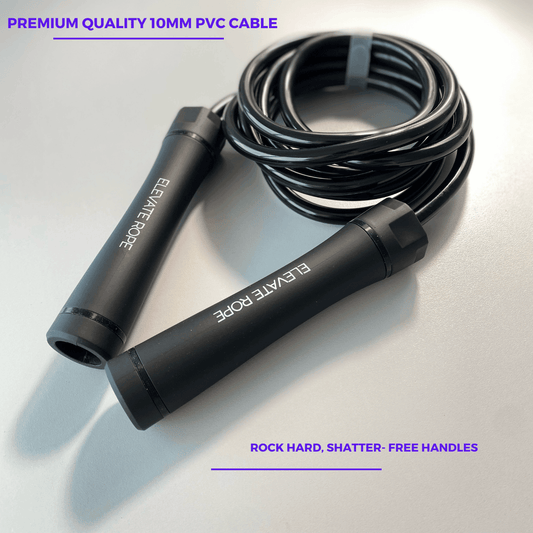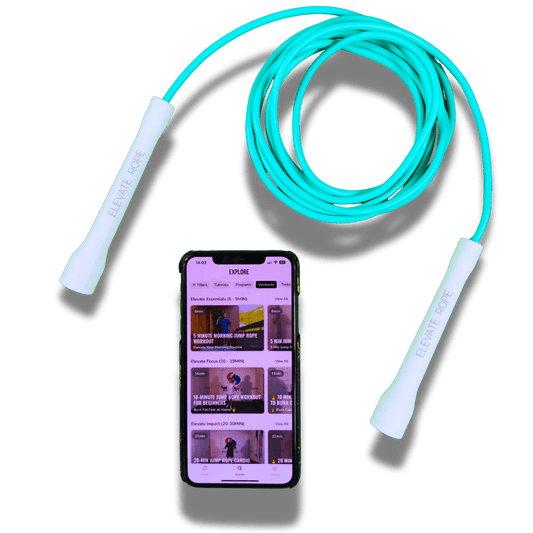Springtouwtrainingen zijn een uitstekende manier om de cardiovasculaire gezondheid te verbeteren, uithoudingsvermogen op te bouwen en calorieën te verbranden. Echter, de juiste voeding is essentieel om de voordelen van je springtouwfitnessregime te maximaliseren. Deze gids voor voeding bij touwtjespringen biedt voedingsaanbevelingen en maaltijdplannen die zijn afgestemd op het ondersteunen van je springtouwtrainingen.

Waarom Voeding bij Touwtjespringen Belangrijk Is
Touwtjespringen is een intensieve training die meerdere spiergroepen aanspreekt en een aanzienlijke hoeveelheid calorieën verbrandt. Om optimaal te presteren, heeft je lichaam de juiste voedingsstoffen nodig om je energie te voeden, spieren te herstellen en effectief te herstellen. Zonder de juiste voeding voor touwtjespringen kun je vermoeidheid, langzamere vooruitgang of zelfs blessures ervaren.
Een goed uitgebalanceerd dieet zorgt ervoor dat je de energie hebt om je trainingen vol te houden, de eiwitten om spieren te herbouwen, en de vitaminen en mineralen om de algehele gezondheid te ondersteunen. Focus op de juiste voedingsmiddelen en timing van maaltijden kan je prestaties verbeteren en je fitnessdoelen sneller bereiken. Dit is waarom je dieet belangrijk is:
- Energievoorziening: Koolhydraten leveren snelle energie voor je sessies.
- Spierherstel: Eiwitten ondersteunen spierherstel en -groei.
- Hydratatie: Gehydrateerd blijven voorkomt krampen en duizeligheid.
- Vet voor Uithoudingsvermogen: Gezonde vetten leveren langdurige energie voor langere trainingen.

Belangrijke Voedingsstoffen voor Springtouwfitness
Om je springtouwtrainingen te optimaliseren, moet je dieet de volgende belangrijke voedingsstoffen bevatten:
1. Koolhydraten: Je Primaire Energiebron
Koolhydraten leveren de energie die nodig is voor intensieve trainingen zoals touwtjespringen. Ze worden afgebroken tot glucose, wat je spieren tijdens het sporten van brandstof voorziet. Kies voor complexe koolhydraten zoals volle granen, fruit, groenten en peulvruchten, omdat deze langdurige energie leveren zonder bloedsuikerpieken te veroorzaken.
2. Eiwitten: Spieren Opbouwen en Herstellen
Eiwit is cruciaal voor spierherstel en -groei. Na een springtouwsessie hebben je spieren eiwitten nodig om te herstellen en sterker te worden. Neem magere eiwitbronnen zoals kip, vis, eieren, tofu, bonen en Griekse yoghurt op in je dieet.
3. Vetten: Ondersteuning van de Algehele Gezondheid
Gezonde vetten zijn belangrijk voor de hormoonproductie en de algehele gezondheid. Verwerk bronnen zoals avocado's, noten, zaden en olijfolie in je maaltijden. Vermijd echter het consumeren van grote hoeveelheden vet vlak voor een training, omdat dit de spijsvertering kan vertragen en je traag kan doen voelen.
4. Hydratatie: Gehydrateerd en Gefocust Blijven
Goed gehydrateerd blijven is cruciaal voor prestatie en herstel. Water helpt de lichaamstemperatuur te reguleren, voedingsstoffen te transporteren en afvalstoffen te verwijderen. Probeer de hele dag water te drinken en overweeg elektrolytrijke dranken als je tijdens trainingen veel zweet.
5. Vitamines en Mineralen: Versterking van Immuniteit en Herstel
Vitamines en mineralen zoals vitamine C, vitamine D, magnesium en ijzer spelen een essentiële rol in energieproductie, spierfunctie en immuungezondheid. Een dieet rijk aan fruit, groenten en volle voedingsmiddelen helpt je micronutriëntenbehoeften te vervullen.
Pre-Workout Voeding voor Springtouw
Wat je eet voor een springtouwtraining kan je prestatie aanzienlijk beïnvloeden. Het doel van pre-workout voeding is je lichaam van de energie te voorzien die het nodig heeft om de sessie krachtig door te komen zonder zwaar of traag te voelen.
- Tijdstip: Eet een uitgebalanceerde maaltijd 2-3 uur voor je training. Als je weinig tijd hebt, neem dan 30-60 minuten voor het springen een kleine snack.
- Wat te Eten: Richt je op gemakkelijk verteerbare koolhydraten en een matige hoeveelheid eiwitten. Bijvoorbeeld een banaan met een eetlepel pindakaas of een snee volkoren toast met avocado.
- Hydratatie: Drink de hele dag door water en neem een glas water 30 minuten voor je training.
Voor meer gedetailleerde tips, bekijk onze gids over pre-workout voeding.
Post-Workout Voeding voor Herstel
Na een springtouwsessie heeft je lichaam voedingsstoffen nodig om energiereserves aan te vullen en spieren te herstellen. Goede post-workout voeding is essentieel voor herstel en vooruitgang.
- Tijdstip: Probeer binnen 30-60 minuten na je training te eten.
- Wat te Eten: Combineer eiwitten en koolhydraten om spierherstel en glycogeenaanvulling te ondersteunen. Voorbeelden zijn een eiwitshake met fruit, gegrilde kip met quinoa, of Griekse yoghurt met bessen.
- Hydratatie: Herhydrateer met water of een elektrolytendrank om verloren vocht door zweet aan te vullen.
Lees meer over het optimaliseren van je herstel met ons artikel over post-workout voeding.
Voorbeeld Springtouw Voedingsmaaltijdplan
Hier is een eendaags maaltijdplan ontworpen om je springtouw fitnessroutine te ondersteunen:
Ontbijt
- Roerei met spinazie en volkoren toast
- Een portie gemengde bessen
- Een glas water of groene thee
Tussendoortje halverwege de ochtend
- Een klein handje amandelen en een appel
Lunch
- Gegrilde kip- of tofu-salade met gemengde groenten, quinoa, cherrytomaatjes en olijfoliedressing
- Een snee volkorenbrood
- Water of kruidenthee
Middagsnack
- Griekse yoghurt met een scheutje honing en chiazaad
Diner
- Gebakken zalm of linzestoofpot met zoete aardappelen en gestoomde broccoli
- Een portie zilvervliesrijst
- Water of een verfrissend infusiewater
Avondsnack (indien nodig)
- Een klein stukje pure chocolade en een handvol walnoten
Touwtjespringvoeding en gewichtsverlies: een gedetailleerde blik
Touwtjespringen is een uitzonderlijk effectieve manier om calorieën te verbranden en gewichtsverlies te bevorderen. De intensieve aard van touwtjespringtrainingen activeert meerdere spiergroepen, wat leidt tot een aanzienlijke calorieverbranding in relatief korte tijd. In combinatie met een goed gestructureerd en uitgebalanceerd dieet kunnen de gewichtsverliesresultaten nog duidelijker zijn.

Om gewichtsverlies te maximaliseren door middel van touwtjespringen en voeding, richt je op het creëren van een calorietekort. Dit betekent dat je minder calorieën consumeert dan je verbrandt. Het is echter cruciaal om ervoor te zorgen dat de calorieën die je binnenkrijgt afkomstig zijn van voedzame, onbewerkte voedingsmiddelen. Deze voedingsmiddelen leveren essentiële vitaminen, mineralen en vezels, die de algehele gezondheid ondersteunen en je een vol en verzadigd gevoel geven.
Hier is een overzicht van belangrijke voedingsaspecten voor gewichtsverlies tijdens het touwtjespringen:
- Geef prioriteit aan eiwitten: Eiwit is essentieel voor spierherstel en -groei, vooral na intensieve touwtjespringsessies. Het helpt ook het verzadigingsgevoel te vergroten, waardoor trek en overeten verminderen. Neem magere eiwitbronnen zoals kip, vis, kalkoen, bonen, linzen en Griekse yoghurt op in je dieet.
- Kies complexe koolhydraten: Complexe koolhydraten, zoals volle granen, zoete aardappelen en zilvervliesrijst, leveren langdurige energie en voorkomen pieken in de bloedsuikerspiegel. Ze zijn ook rijk aan vezels, wat de spijsvertering bevordert en zorgt voor een vol gevoel.
- Neem gezonde vetten op: Gezonde vetten, te vinden in avocado's, noten, zaden en olijfolie, zijn cruciaal voor hormoonproductie en algehele gezondheid. Ze helpen ook bij de opname van vetoplosbare vitamines en dragen bij aan een verzadigd gevoel.
- Beheers portiegroottes: Zelfs gezonde voedingsmiddelen kunnen leiden tot gewichtstoename als ze in te grote hoeveelheden worden geconsumeerd. Let op portiegroottes en gebruik meetinstrumenten indien nodig.
- Blijf gehydrateerd: Voldoende water drinken is essentieel voor gewichtsverlies en algehele gezondheid. Water helpt gifstoffen af te voeren, ondersteunt de spijsvertering en kan je een vol gevoel geven.
- Beperk bewerkte voedingsmiddelen, suikerhoudende dranken en overmatige natrium: Bewerkt voedsel, suikerhoudende dranken en te veel natrium kunnen gewichtsverlies belemmeren en je gezondheid negatief beïnvloeden. Richt je op onbewerkte, natuurlijke voedingsmiddelen voor optimale resultaten.
- Maaltijdtijdstip: Hoewel het niet zo cruciaal is als de totale calorie-inname, vinden sommige mensen dat het tijdstip van maaltijden kan helpen bij gewichtsverlies. Overweeg kleinere, frequentere maaltijden gedurende de dag te eten om stabiele bloedsuikerspiegels te behouden en overeten te voorkomen.
- Luister naar je lichaam: Let op je hongergevoel en verzadigingssignalen. Vermijd eten als je geen honger hebt en stop met eten als je tevreden bent, niet vol.
Je kunt effectief calorieën verbranden, afvallen en je algehele fitheid en welzijn verbeteren door consistente touwtjespringworkouts te combineren met een uitgebalanceerd, voedzaam dieet. Bekijk ons uitgebreide artikel over touwtjespringuitdagingen voor gewichtsverlies.
Veelgestelde vragen over touwtjespringen, voeding en fitness
● Kan springen met een springtouw buikvet verbranden?
Ja, touwtjespringen is een effectieve manier om calorieën te verbranden en het totale lichaamsvet, inclusief buikvet, te verminderen. Echter, plaatselijke vetverbranding is niet mogelijk. Het combineren van touwtjespringen met een uitgebalanceerd dieet en krachttraining helpt je een slanker lichaam te bereiken.
● Is 1000 sprongen per dag goed?
1.000 keer per dag touwtje springen is een uitstekend startpunt voor beginners. Het kan helpen de cardiovasculaire conditie, coördinatie en uithoudingsvermogen te verbeteren. Naarmate je vordert, kun je het aantal sprongen verhogen of meer geavanceerde technieken toepassen.
● Is 20 minuten touwtje springen genoeg?
Ja, 20 minuten touwtje springen kan een effectieve training zijn, vooral als het op hoge intensiteit wordt gedaan. Het is een tijdbesparende manier om calorieën te verbranden en je conditie te verbeteren. Voor beginners is het aan te raden te starten met kortere sessies en de duur geleidelijk te verhogen naarmate je uithoudingsvermogen verbetert.
● Is touwtje springen beter dan hardlopen?
Zowel touwtje springen als hardlopen zijn uitstekende vormen van cardio, maar ze bieden verschillende voordelen. Touwtje springen is een low-impact oefening die de coördinatie verbetert en in een kleine ruimte kan worden gedaan. Hardlopen daarentegen is geweldig voor het opbouwen van uithoudingsvermogen en kan toegankelijker zijn voor langere duur. De beste keuze hangt af van je fitnessdoelen en voorkeuren.
Verhoog je springtouwspel met de juiste uitrusting
Nu je hebt geleerd hoe je je lichaam kunt voorzien van brandstof voor succes met touwtjespringen, is het tijd om jezelf uit te rusten met de beste hulpmiddelen voor de klus. Wij bieden hoogwaardige springtouwen aan, waaronder verzwaarde, pareltjes en speed ropes, ontworpen om je trainingen te verbeteren. Of je nu een beginner bent of een ervaren atleet, onze touwen zijn gemaakt om je te helpen je fitnessdoelen te bereiken.
Klaar om je springtouwfitness naar een hoger niveau te tillen? Ontdek onze collectie premium springtouwen bij Elevate Rope en vind het perfecte touw voor jouw behoeften.
Conclusie
Goede voeding voor touwtjespringen is de sleutel tot het ontsluiten van je volledige potentieel en het bereiken van je fitnessdoelen. Door je te richten op een uitgebalanceerd dieet, je maaltijden op het juiste moment te plannen en gehydrateerd te blijven, kun je je lichaam voorzien van brandstof voor optimale prestaties en herstel. Vergeet niet onze gerelateerde artikelen over voedingsregels, pre-workout voeding en post-workout voeding te bekijken voor meer tips en inzichten.
Combineer je voedingsplan met de juiste uitrusting van Elevate Rope, en je bent goed op weg om een springtouwprofessional te worden. Begin vandaag nog aan je reis en ervaar de transformerende kracht van springtouwfitness!
Geniet Je Van Dit Artikel? Misschien Vind Je Dit Ook Leuk:
- Tips voor trainen tijdens het herstel van een opioïdverslaving
- Zorg voor jezelf tijdens de vakantie: tips om workouts en dieet tijdens de feestdagen bij te houden
- Medische misdiagnose: de rol van second opinions bij het voorkomen van medische misdiagnoses
- Een uitgebalanceerde fitnessroutine creëren: cardio, kracht en holistische praktijken
- Moet u alcohol drinken tijdens het gebruik van Semaglutide? Wat u moet weten in 2024 en daarna
